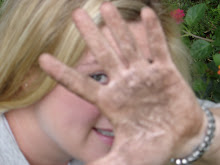
As you all know, I have a thirty year old house that has thirty year old trees. This being said, I have very limited full sun exposure. I am also very interested in growing some of my own produce. Because fruits and vegetables need full sun for optimal health, I have decided to think outside of the box and create a rotating container vegetable garden- on my driveway. First up-lettuce. I purchased a pre-formed pond liner and drilled drainage holes in the bottom. I then went to my local shipping store and asked for some packing peanuts. I filled the container 1/4 full with the packing peanuts(for ease of movement, and because lettuce has a shallow root system) and then layered in organic garden soil, premium top soil and good old composted cow manure. I planted 7 Buttercrunch and 7 Red Sail lettuces as well as three marigolds for good measure. As we all know, rabbits love lettuce and because this is approximately two feet off the ground and is solid, my thought is that they won't climb and can't burrow but if that doesn't stop them the marigolds will. My final step is to locate an old whiskey barrel half to mount it in so it looks more intentional from the street. Will follow with more pictures when the lettuce has matured a bit.




